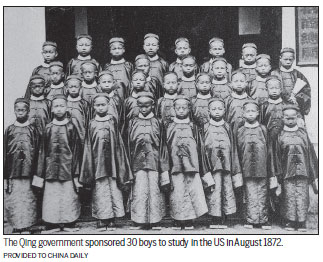The history of Chinese studying abroad

Chinese students embarking on educational endeavors in foreign lands was something that had taken place as early as the Qing Dynasty (1644-1911).
Historical records show that three teenagers from the Chinese mainland - they were top performers at a school established by American missionaries in Macao - were among the first in history to have studied overseas in the United States.
One of these individuals was Rong Hong, who was then 19. A native of Guangdong province, Rong sailed for 98 days before arriving in New York. He graduated from Yale University in 1854 and later published an autobiography titled My Life in China and America.
In August 1872, the Chinese government sponsored 30 boys to study abroad. Among this historic batch of students was Zhan Tianyou, who later designed and built China's first railway, and Liang Guoyan, who became a foreign affairs officer and was posted to the US.
However, it was only in the 1980s, following China's reform and opening-up, that Chinese students starting flocking overseas in droves.
When the Test of English as a Foreign Language (TOFEL), a compulsory test that people needed to take in order to apply to a university in the United States or Canada, first landed on the Chinese mainland in December 1981, 285 people took the test.
The number of participants surged to 8,000 in 1985. Just five years later, more than 40,000 people took the TOFEL.
According to a report by China National Radio, the national government had in 1985 put forward the idea of supporting Chinese youth in their overseas studies, resulting in more than 100,000 people going abroad to do so at their own expense the following year.
The phenomenon was especially strong in Shanghai, with a documentary aired by the Shanghai Television Station describing the trend as "epic".
"An English-learning spree started in the city. Radio sets, which were considered an important tool for learning a foreign language, were quickly snapped up across the city.
The famous English corner in People's Park in central Shanghai came into being naturally at that time," said Zhou Haiwang, deputy-director of the Institute of Population and Development at the Shanghai Academy of Social Sciences.
Japan, which is only a three-hour flight from Shanghai, was one of the popular destinations among Shanghainese students. Zhou said more than 100,000 Shanghai residents headed for Japan to study and work in the late 1980s.
Wang Zhen was one of them. After marrying his wife in 1988, he left the country to further his studies at the University of Tokyo in 1989. Like many other Shanghai natives in Japan, he earned money by working in restaurants and barber shops during his spare time.
"That was like a chance of a lifetime to make money. What I earned from a month's work in Japan was nearly equivalent to what I would've earned in two years if I were an average worker in Shanghai," Wang said.
zhouwenting@chinadaily.com.cn








